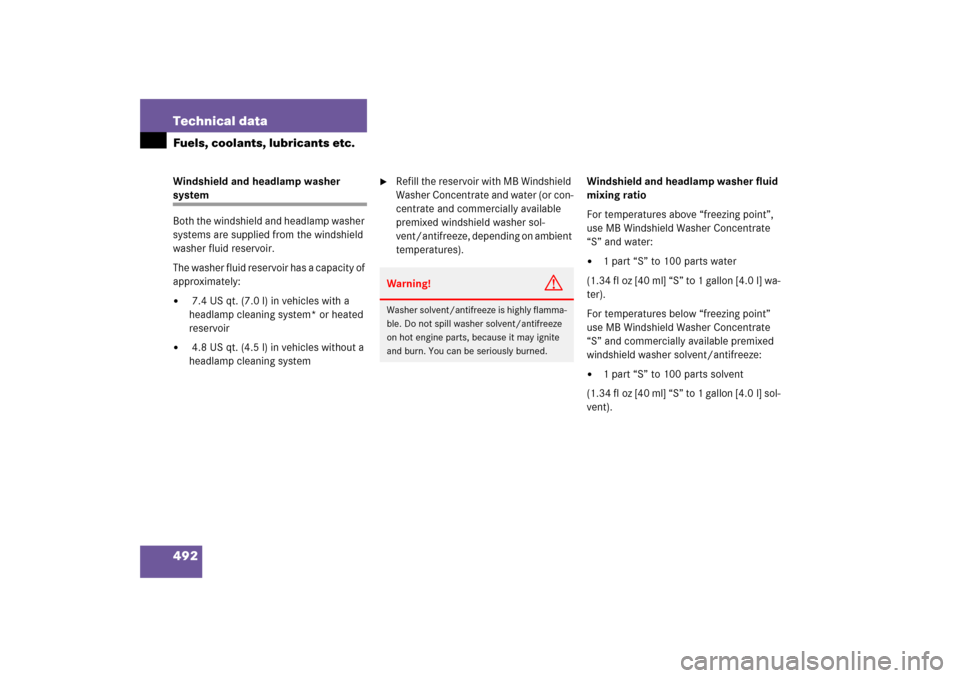Page 319 of 521

318 OperationAt the gas stationWindshield washer system and
headlamp cleaning system*
For information on refilling the reservoir,
see “Windshield washer system and
headlamp cleaning system*”
(�page 327).
Brake fluid
For information on brake fluid, see “Fuels,
coolants, lubricants etc.” (
�page 484).Coolant
For normal replenishing, use water (pota-
ble water quality). For more information on
coolant, see “Coolant level” (
�page 325)
and see “Fuels, coolants, lubricants etc.”
(
�page 484).
Engine oil level
For more information on engine oil level,
see “Engine oil” (
�page 320).Vehicle lighting
Check function and cleanliness. For more
information on replacing light bulbs, see
“Replacing bulbs” (
�page 433).
For more information, see “Exterior lamp
switch” (
�page 141).
Tire inflation pressure
For more information, see “Checking tire
inflation pressure” (
�page 339).
!If you find that the brake fluid in the
brake fluid reservoir has fallen to the
minimum mark or below, have the
brake system checked for brake pad
thickness and leaks immediately. Noti-
fy an authorized Mercedes-Benz Center
immediately. Do not add brake fluid as
this will not solve the problem. For
more information, see “Practical hints”
(�page 376).
Page 326 of 521

325 Operation
Engine compartment
Coolant level
The engine coolant is a mixture of water
and anticorrosion/antifreeze. To check
the coolant level, the vehicle must be
parked on level ground and the engine
must be cool.
The coolant expansion tank is located on
the driver’s side of the engine compart-
ment.
1Coolant expansion tank
�
Using a rag, turn the cap slowly approx-
imately one half turn to the left to re-
lease any excess pressure.
�
Continue turning the cap to the left and
remove it.
The coolant level is correct if the level:�
for cold coolant: reaches the black
top part of the reservoir
�
for warm coolant: is approximately
0.6 in (1.5 cm) higher
�
Add coolant as required.
�
Replace and tighten cap.
For more information on coolant, see the
“Technical data” section (
�page 490).
Warning!
G
In order to avoid any possibly serious burns:�
Use extreme caution when opening the
hood if there are any signs of steam or
coolant leaking from the cooling system,
or if the coolant temperature gauge indi-
cates that the coolant is overheated.
�
Do not remove pressure cap on coolant
reservoir if coolant temperature is
above 158°F (70°C). Allow engine to
cool down before removing cap. The
coolant reservoir contains hot fluid and
is under pressure.
�
Do not spill antifreeze on hot engine
parts. Antifreeze contains ethylene gly-
col which may burn if it comes into con-
tact with hot engine parts.
�
Using a rag, slowly open the cap approx-
imately
1/2 turn to relieve excess pres-
sure. If opened immediately, scalding
hot fluid and steam will be blown out un-
der pressure.
Page 380 of 521

379 Practical hints
What to do if …
Problem
Possible cause/consequence
Suggested solution
D
The red coolant warning lamp
comes on when the engine is
running.
There is insufficient coolant in the reservoir.
If this warning lamp comes on frequently,
there is a leak in the cooling system.
If the coolant level is correct, the electric ra-
diator fan may be broken.
�
Immediately add coolant to prevent
engine from overheating
(�page 325).
�
Have the cooling system checked.
�
If the coolant temperature is below
257°F (125°C), you can continue
driving to the nearest authorized
Mercedes-Benz Center.
�
Avoid high engine loads (e.g. driving
uphill) and stop-and-go driving.
The red coolant warning lamp
comes on while driving and you
hear a warning sound.
The coolant temperature has exceeded
257°F (125°C).
�
Stop as soon as possible in a safe lo-
cation and allow the engine and cool-
ant to cool down.
Warning!
G
Driving when your engine is badly overheat-
ed can cause some fluids which may have
leaked into the engine compartment to
catch fire. You could be seriously burned.
Steam from an overheated engine can cause
serious burns and can occur just by opening
the engine hood. Stay away from the engine
if you see or hear steam coming from it.
Turn off the engine, get out of the vehicle
and do not stand near the vehicle until the
engine has cooled down.
Page 493 of 521

492 Technical dataFuels, coolants, lubricants etc.Windshield and headlamp washer system
Both the windshield and headlamp washer
systems are supplied from the windshield
washer fluid reservoir.
The washer fluid reservoir has a capacity of
approximately:�
7.4 US qt. (7.0 l) in vehicles with a
headlamp cleaning system* or heated
reservoir
�
4.8 US qt. (4.5 l) in vehicles without a
headlamp cleaning system
�
Refill the reservoir with MB Windshield
Washer Concentrate and water (or con-
centrate and commercially available
premixed windshield washer sol-
vent/antifreeze, depending on ambient
temperatures).Windshield and headlamp washer fluid
mixing ratio
For temperatures above “freezing point”,
use MB Windshield Washer Concentrate
“S” and water:
�
1 part “S” to 100 parts water
(1.34 fl oz [40 ml] “S” to 1 gallon [4.0 l] wa-
ter).
For temperatures below “freezing point”
use MB Windshield Washer Concentrate
“S” and commercially available premixed
windshield washer solvent/antifreeze:
�
1 part “S” to 100 parts solvent
(1.34 fl oz [40 ml] “S” to 1 gallon [4.0 l] sol-
vent).
Warning!
G
Washer solvent/antifreeze is highly flamma-
ble. Do not spill washer solvent/antifreeze
on hot engine parts, because it may ignite
and burn. You can be seriously burned.